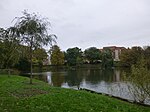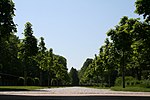Ydre Østerbro
Ydre Østerbro (lit. English: Outer Østerbro) is an area in Copenhagen, Denmark. It is the part of the district of Østerbro located farthest from the City Centre. It lies on the northeast border of the municipality. It covers an area of 5.08 km2, has a population of 35,937 and a population density of 7,081 per km2. Neighboring city districts are as follows: to the north is Gentofte municipality, which is outside of the Copenhagen municipality area to the west are Bispebjerg and Ydre Nørrebro to the south is Indre Østerbro to the east is Svanemølle Bay (Svanemøllebugten), an inlet of the Øresund, the strait which separates the island of Zealand from SwedenColloquially, the Ydre Østerbro ("Outer Østerbro"), along with its neighboring city district to the south— Indre Østerbro ("Inner Østerbro")— are often collectively referred to as "Østerbro". However, they are technically two separate legal units within the Copenhagen municipality.
Excerpt from the Wikipedia article Ydre Østerbro (License: CC BY-SA 3.0, Authors).Ydre Østerbro
Ryparken, Copenhagen
Geographical coordinates (GPS) Address Website Nearby Places Show on map
Geographical coordinates (GPS)
| Latitude | Longitude |
|---|---|
| N 55.72 ° | E 12.5628 ° |
Address
Fægteklubben Trekanten
Ryparken
2900 Copenhagen
Capital Region of Denmark, Denmark
Open on Google Maps








